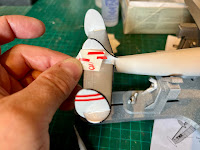Next up, another Spitfire!
This is one I’ve been waiting for the right moment to build as it has a bit of a story.
Today would have been my father’s 90th birthday. He passed Christmas 2021 and while I was up at my parents’ Cumbria home doing that eldest brother thing, I got a call from Airfix’s Michael Clegg asking if he could use two of my Sea King helicopters in a spread he was working on for his Workbench blog.
See here: https://uk.airfix.com/community/blog-and-news/workbench/mitchells-masterpiece-inherits-griffon-power
This not only helped take our minds off the reason why I had had to dash north but also introduced me to a fact about one of my favourite aircraft which I had not previously known.
One of the last fighter versions of the Spitfire, the Mk.XVIII flew on “Operation Firedog” in Malaya during the 1950s Emergency just my father was out there with the British Army, or at least en route.
At the time I was talking to Michael Clegg about the Sea Kings he kindly offered to send me an Airfix kit in return for using my models and story. I naturally suggested the Spitfire would be the perfect one considering its significance: my father having served in Malaya at more or less the same time, and for it being unveiled in the same article as my Sea Kings. Anyway, despite many a friendly follow up on my part, nothing ever arrived from Michael and so, I was fortunate enough to have sufficient Airfix flying hours to ensure I secured a kit before it sold out, and it’s been in my stash ever since.
It now seems only right to mark this, my father’s 90th birthday, to finally build it.
Development of the Spitfire F Mk.XVIII the 'Super Spitfire' was started towards the end of 1943 and the first Mk.XVIII Griffin 65 powered Spitfire was delivered to the RAF on 28 May 1945. 99 aircraft were completed for the fighter/bomber role with the provision for wing mounted bombs and rockets.
One of the first tasks when building this kit is to drill out holes for either bombs or rockets. Airfix’s painting instructions, state they were in Kuala Lumpur in 1947, but it wasn’t actually until the end of June 1948 that 60 Sqn provided a detachment of their Spitfires to the Taskforce at Kuala Lumpur, which was also the first time they used rockets too which is what I’ve gone for. More on their use in the Malayan Emergency later.
Some will hate my approach with the cockpit interior. Being so beautifully moulded it seems horrifying not to paint and weather every nook and bump. However, having built the Spitfire FR Mk.XIV last year with pilot installed, I know you can see nothing at all of that interior once it's all put together. So as my new mantra is, only paint what you can see I've fitted the pilot in his seat and added a little of putty to his arm joints ready for one of my favourite bits, the detail brush painting.
Meanwhile, here’s how and when the first Spitfire to be delivered was reported.
JANUARY 1947 (OPERATIONS) F/O QUILTER
“There has been little flying on the Squadron this month, principally because of a shortage of aircraft. On the 15th our first Spitfire Mk.XVIII was flown from Seletar by the Commanding Officer, Squadron Leader Constable Maxwell DFC, DFC but apart from this one Spitfire there has only been our Harvard and another Harvard obligingly loaned by 81 Squadron.
Our home field, Tenah, only became serviceable for limited flying as recently as the 29th, of this month when our two aircraft were flown over from Seletar. The flying we had managed to do previously had entailed our making the tiresome journey to Seletar by road everyday, thereby shortening our airborne hours even further.
Next month, fortunately, holds brighter prospects as several more of our keenly awaited Spitfires are very near completion and the Tenah runways should become closer to full serviceability.”
I feel my building of of TP222 is one of the Spitfires keenly awaited though it is still some way off being completed























